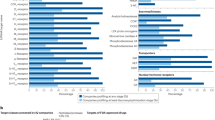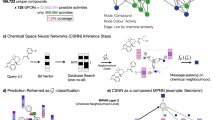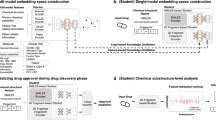Abstract
We present the global mapping of pharmacological space by the integration of several vast sources of medicinal chemistry structure-activity relationships (SAR) data. Our comprehensive mapping of pharmacological space enables us to identify confidently the human targets for which chemical tools and drugs have been discovered to date. The integration of SAR data from diverse sources by unique canonical chemical structure, protein sequence and disease indication enables the construction of a ligand-target matrix to explore the global relationships between chemical structure and biological targets. Using the data matrix, we are able to catalog the links between proteins in chemical space as a polypharmacology interaction network. We demonstrate that probabilistic models can be used to predict pharmacology from a large knowledge base. The relationships between proteins, chemical structures and drug-like properties provide a framework for developing a probabilistic approach to drug discovery that can be exploited to increase research productivity.
This is a preview of subscription content, access via your institution
Access options
Subscribe to this journal
Receive 12 print issues and online access
$259.00 per year
only $21.58 per issue
Buy this article
- Purchase on SpringerLink
- Instant access to full article PDF
Prices may be subject to local taxes which are calculated during checkout






Similar content being viewed by others
References
Schuffenhauer, A. & Jacoby, E. Annotating and mining the ligand-target chemogenomics knowledge space. Drug Discov. Today: BIOSILICO 2, 190–200 (2004).
Strausberg, R.L. & Schreiber, S.L. From knowing to controlling: a path from genomics to drugs using small molecule probes. Science 300, 294–295 (2003).
Weinstein, J.N. et al. An information intensive approach to the molecular pharmacology of cancer. Science 275, 343–349 (1997).
Roth, B.L., Kroeze, W.K., Patel, S. & Lopez, E. The multiplicity of serotonin receptors: uselessly diverse molecules or an embarrasment of riches? Neuroscientist 6, 252–262 (2000).
Krejsa, C.M. et al. Predicting ADME properties and side effects: the BioPrint approach. Curr. Opin. Drug Discov. Develop. 6, 470–480 (2003).
Horvath, D. & Jeandenans, C. Neighborhood behavior of in silico structural spaces with respect to in vitro activity spaces-a novel understanding of the molecular similarity principle in the context of multiple receptor binding profiles. J. Chem. Inf. Comput. Sci. 43, 680–690 (2003).
Root, D.E., Flaherty, S.P., Kelley, B.P. & Stockwell, B. Biological mechanism profiling using an annotated compound library. Chem. Biol. 10, 881–892 (2003).
Wallqvist, A. et al. Mining the NCI screening database: explorations of agents involved in cell cycle regulation. Prog. Cell Cycle Res. 5, 173–179 (2003).
Piatetski-Shapiro, G. & Frawley, W. Knowledge Discovery in Databases (MIT Press, Cambridge, 1992).
Klösgen, W. & Zytkow, J.M. (eds.). Handbook of Data Mining and Knowledge Discovery (Oxford University Press, Oxford, 2002).
Drews, J. Genomic sciences and the medicine of tomorrow. Nat. Biotechnol. 14, 1516–1518 (1996).
Drews, J. & Ryser, S. Classic drug targets. Nat. Biotechnol. 15, 1318–1319 (1997).
Hopkins, A.L. & Groom, C.R. The druggable genome. Nat. Rev. Drug Discov. 1, 727–730 (2002).
Golden, J.B. Prioritizing the human genome: knowledge management for drug discovery. Curr. Opin. Drug Discov. Develop. 6, 310–316 (2003).
Lipinski, C.A., Lombardo, F., Dominy, B.W. & Feeney, P.J. Experimental and computational approaches to estimate solubility and permeability in drug discovery and development settings. Adv. Drug Del. Rev. 23, 3–25 (1997).
Van Gestel, S. & Schuermans, V. Thirty-three years of drug discovery and research with Dr. Paul Janssen. Drug Dev. Res. 8, 1–13 (1986).
Sneader, W. Drug Prototypes and Their Exploitation (Wiley, London, 1996).
Wermuth, C.G. Selective optimization of side activities: another way for drug discovery. J. Med. Chem. 47, 1303–1314 (2004).
McGovern, S.L., Helfand, B.T., Feng, B. & Shoichet, B.K. A specific mechanism of nonspecific inhibition. J. Med. Chem. 46, 4265–4272 (2003).
Vieth, M. et al. Kinomics—structural biology and chemogenomics of kinase inhibitors and targets. Biochim. Biophys. Acta 1697, 243–257 (2004).
Vieth, M., Sutherland, J.J., Robertson, D.H. & Campbell, R.M. Kinomics: characterizing the therapeutically validated kinase space. Drug Discov. Today 10, 839–846 (2005).
Frye, S.V. Structure-activity relationship homology (SARAH): a conceptual framework for drug discovery in the genomic era. Chem. Biol. 6, R3–R7 (1999).
Xia, X., Maliski, E.G., Gallant, P. & Rogers, D. Classification of kinase inhibitors using a Bayesian model. J. Med. Chem. 47, 4463–4470 (2004).
Rogers, D., Brown, R.D. & Hahn, M. Using extended-connectivity fingerprints with laplacian-modified Bayesian analysis in high-throughput screening follow-up. J. Biomol. Screen. 10, 682–686 (2005).
Lipinski, C. & Hopkins, A. Navigating chemical space for biology and medicine. Nature 432, 855–861 (2004).
Vieth, M. et al. Characteristic physical properties and structural fragments of marketed oral drugs. J. Med. Chem. 47, 224–232 (2004).
Wenlock, M.C., Austin, R.P., Barton, P., Davis, A.M. & Leeson, P.D. A comparison of physiochemical property profiles of development and marketed oral drugs. J. Med. Chem. 46, 1250–1256 (2003).
Blake, J.F. Examination of the computed molecular properties of compounds selected for clinical development. Biotechniques (June) Suppl.,16–20 (2003).
Ajay, A., Walters, W.P. & Murcko, M.A. Can we learn to distinguish between “drug-like” and “nondrug-like” molecules? J. Med. Chem. 41, 3314–3324 (1998).
Lipinski, C.A. Drug-like properties and the causes of poor solubility and poor permeability. J. Pharmacol. Toxicol. Methods 44, 235–249 (2000).
Wang, J. & Ramnarayan, K. Towards designing drug-like libraries: a novel computational approach for prediction of drug feasibility of compounds. J. Comb. Chem. 1, 524–533 (1999).
Walters, W.P. Ajay & Murcko, M.A. Recognizing molecules with drug-like properties. Curr. Opin. Chem. Biol. 3, 384–387 (1999).
Podlogar, B.L., Muegge, I. & Brice, L.J. Computational methods to estimate drug development paramenters. Curr. Opin. Drug Discov. Devel. 4, 102–109 (2001).
Muegge, I., Heald, S.L. & Brittelli, D. Simple selection criteria for drug-like chemical matter. J. Med. Chem. 44, 1841–1846 (2001).
Veber, D.F. et al. Molecular properties that influence the oral bioavailability of drug candidates. J. Med. Chem. 45, 2615–2623 (2002).
Proudfoot, J.R. Drugs, leads, and drug-likeness: an analysis of some recently launched drugs. Bioorg. Med. Chem. Lett. 12, 1647–1650 (2002).
Egan, W.J., Walters, W.P. & Murcko, M.A. Guiding molecules towards drug-likeness. Curr. Opin. Drug Discov. Devel. 5, 540–549 (2002).
Walters, W.P. & Murcko, M.A. Prediction of 'drug-likeness'. Adv. Drug Deliv. Rev. 54, 255–271 (2002).
Muegge, I. Selection criteria for drug-like compounds. Med. Res. Rev. 23, 302–321 (2003).
Lajiness, M.S., Vieth, M. & Erickson, J. Molecular properties that influence oral drug-like behavior. Curr. Opin. Drug Discov. Devel. 7, 470–477 (2004).
Stockwell, B.R. Chemical genetics: ligand-based discovery of gene function. Nat. Rev. Genet. 1, 116–125 (2000).
Austin, C.P., Brady, L.S., Insel, T.R. & Collins, F.S. NIH Molecular Libraries Initiative. Science 306, 1138–1139 (2004).
Schuffenhauer, A. et al. An ontology for pharmaceutical ligands and its applications for in silico screening and library design. J. Chem. Inf. Comput. Sci. 42, 947–955 (2002).
Feldman, H.J., Dumontier, M., Ling, S., Haider, N. & Hogue, C.W. CO: A chemical ontology for identification of functional groups and semantic comparison of small molecules. FEBS Lett. 579, 4685–4691 (2005).
Roth, B.L., Sheffler, D.J. & Kroeze, W.K. Magic shotguns versus magic bullets: selectively non-selective drugs for mood disorders and schizophrenia. Nat. Rev. Drug Discov. 3, 353–359 (2004).
Frantz, S. Drug discovery: playing dirty. Nature 437, 942–943 (2005).
Connolly, T. & Begg, C. Database Systems, A Practical Approach to Design, Implementation and Management., edn. 3 (Addison Wesley, Reading, MA, 2002).
Shannon, P. et al. Cytoscape: a software environment for integrated models of biomolecular interaction networks. Genome Res. 13, 2498–2504 (2003).
R Core Development Team. A Language and Environment for Statistical Computing (R Foundation for Statistical Computing, Vienna, 2005).
Andrews, P.R., Craik, D.J. & Martin, J.L. Functional group contributions to drug-receptor interactions. J. Med. Chem. 27, 1648–1657 (1984).
Hopkins, A.L., Groom, C.R. & Alex, A. Ligand efficiency: a useful metric for lead selection. Drug Discov. Today 9, 430–431 (2004).
Kuntz, I.D., Chen, K., Sharp, K.A. & Kollman, P.A. The maximal affinity of ligands. Proc. Natl. Acad. Sci. USA 96, 9997–10002 (1999).
Acknowledgements
We want to thank an unknown referee for very helpful comments and suggestions. Thanks to Federica Massagrande, Emma Williamson, Sid Martin, Phil Brain, Bryn Williams-Jones, Jens Loesel, Mark Gardner, Nigel Wilkinson, Steve Pimblett, Giles Ratcliffe, Jerry Lanfear, Carolyn Barker, Tony Wood, Frank Burslem and Colin Groom. In particular, we would like to thank John Overington, Bissan Al-Lazikani, John Bradshaw and Yosi Taitz. Thanks to Alan Newton and the PGRDi Innovation Fund for financial support.
Author information
Authors and Affiliations
Contributions
G.V.P., database design and production and knowledge discovery; R.H.B.S., database design and production; W.P.v.H., predictive modeling; J.S.M., chemical representation; A.L.H., database design and knowledge discovery.
Corresponding author
Ethics declarations
Competing interests
All of the authors were or are employees (or contract employees) of Pfizer.
Supplementary information
Supplementary Fig. 1
Bayesian polypharmacology prediction results of Cerep BioPrint data set. (PDF 60 kb)
Supplementary Fig. 2
Bayesian predicted polypharmacology interaction network. (PDF 169 kb)
Supplementary Fig. 3
Supplementary Information to Figure 4. (PDF 598 kb)
Supplementary Table 1
Table of Supplementary Information for Figure 2. (PDF 128 kb)
Supplementary Table 2
Table of Supplementary Information to Figure 3. (PDF 59 kb)
Supplementary Table 3
Supplementary Information for Supplementary Figure 1. (PDF 60 kb)
Supplementary Table 4
Bayesian predicted polypharmacology interaction network for Cerep Bioprint set. (PDF 54 kb)
Supplementary Table 5
Predictions of gene family classification of biologically-active compounds by physico-chemical properties, using Linear Discriminant Analysis. (PDF 60 kb)
Rights and permissions
About this article
Cite this article
Paolini, G., Shapland, R., van Hoorn, W. et al. Global mapping of pharmacological space. Nat Biotechnol 24, 805–815 (2006). https://doi.org/10.1038/nbt1228
Published:
Issue date:
DOI: https://doi.org/10.1038/nbt1228
This article is cited by
-
A novel in silico scaffold-hopping method for drug repositioning in rare and intractable diseases
Scientific Reports (2023)
-
Repurposing Cardio-Metabolic Drugs to Fight Covid19
High Blood Pressure & Cardiovascular Prevention (2021)
-
The kinase polypharmacology landscape of clinical PARP inhibitors
Scientific Reports (2020)
-
Bioactivity-explorer: a web application for interactive visualization and exploration of bioactivity data
Journal of Cheminformatics (2019)
-
Drug repurposing for antimicrobial discovery
Nature Microbiology (2019)



